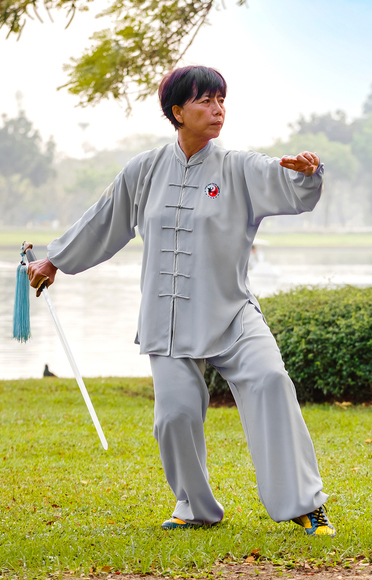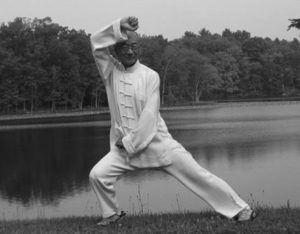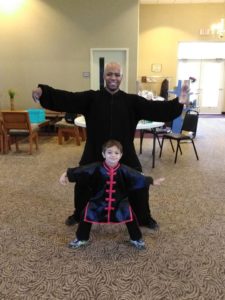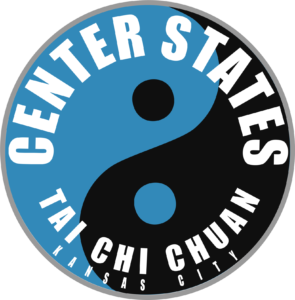Slanted FlyingJournal of Tai Chi Chuan
Training
Taiji Sword (劍 Jian)
It is wrong to try and hold the sword as lightly as one can, in the mistaken understanding that a soft grip is the yin (阴) to the hard sword’s yang (阳). The grip itself should demonstrate both qualities of yin and yang, which is how the hand acts like an additional joint for the sword, and produces the fluidity of motion characteristic of the handling of this weapon. If one is holding the sword loosely and lightly, but without the firmness necessary for contact with another’s weapon, then one is just dancing with a light prop rather than trying to understand the functionality of historic swords.
 The “joint” at the hand/wrist/blade root is used in support of the actions in the other three pivot points of the sword rather than independently as its own motion. A light jian with a balance point close to the guard is typically moved primarily by using the wrist independently of the other pivot points. Even if a jian like this is being used, practitioners should try to coordinate the hand/wrist/blade root with the pivot points farther out on the sword. One wants to be able to “snake” the sword around when using applications against an opponent, and this requires both flexibility at the hand/wrist/blade root, and pivoting around multiple points along the blade. One also should maintain the flexible strength of the snake by not having a too tight grip.
The “joint” at the hand/wrist/blade root is used in support of the actions in the other three pivot points of the sword rather than independently as its own motion. A light jian with a balance point close to the guard is typically moved primarily by using the wrist independently of the other pivot points. Even if a jian like this is being used, practitioners should try to coordinate the hand/wrist/blade root with the pivot points farther out on the sword. One wants to be able to “snake” the sword around when using applications against an opponent, and this requires both flexibility at the hand/wrist/blade root, and pivoting around multiple points along the blade. One also should maintain the flexible strength of the snake by not having a too tight grip.
When interacting from contact, practitioners should typically have the deflecting or “following” side of the sword be yin while pivoting another part of the sword, which becomes the yang side, into an attack (or potential attack). One side of the pivot point becomes yin while the other side of the pivot point becomes yang. This differentiation between yin and yang is facilitated when one can control the pivot point of their sword, and this is made easier with proper historical balance.
However, differentiating into yin and yang around a pivot point is not a fixed rule since there are various techniques where both sides of the contact point become yang; for example, techniques that are used to obstruct or hinder the opponent’s weapon, like lan (攔 block), ge (格 obstruct) and ya (压 press), or techniques like tuo (托 support) that deflect an opponent’s weapon up and off target.
The relationship between movement in the “joint” at the hand/wrist/blade root and pivoting near the blade’s point of balance is especially evident in techniques like dian (点 dot or peck, where the handle is raised to cause the tip to go forward and/or down), beng (弸 flick, where the handle is snapped down to cause the tip to explode upward), and pao (拋 fling, where the sword is snapped to one side or the other). When done slowly this relationship may not be as obvious as when the techniques are done with speed.
When a sword with historically accurate weight and balance is used in a manner analogous to the tip of the sword being the head of a snake, and the sword and the hand and arm that are holding it move like the body of the snake, then the practitioner develops the hands and arms for extending the energy through the sword. Too much use of the isolated wrist joint “breaks” the snake’s body in half, with less energy extension than should be evident in Taiji jian usage. Don’t put a hinge in the middle of the snake’s body!
While the jian was used through most of Chinese history, by the Qing Dynasty its usage as a military weapon was essentially eliminated in favor of the dao. The dao has more of the foundational methods for short weapons usage and is easier to learn, whereas the jian required more studied and difficult methods for proficiency. Therefore, the jian became associated with study and refinement, and became associated with scholars. Unfortunately, this lead to the jian being used as a symbol, and it was often simply used as an item of fashion or status rather than for combat.
Practitioners who want to understand the functionality of the jian should take care to understand the intricacies of using this weapon, including its historically accurate weight and balance. Most of the jian form performances shown today are done more like dances, and much of the functionality as a weapon has been ignored.
Talk about how the tassel symbolizes the yin balance to the yang sword is merely scholarly intellectualizing about the jian for dance rather than the functionality of the jian as a weapon. The light weight of a full length tassel should not significantly alter the balance point of a historically weighted jian. Extremely short tassels, that some performers use, are merely a way to avoid the tassel tangling around the performer’s wrist or arm when they are rapidly flicking the sword around with wrist movements. The short tassel is just for eye catching show and has no other function.
Ancient statues and other artworks depict swords with long tassels but, due to the perishable nature of the tassels, historic artifacts are rarely available. Still, practitioners should be able to use the tassel in a combat relevant manner. There is even some evidence that tassels could occasionally have sharp items included that would lacerate an opponent that was hit with it.
In the forms that I am familiar with that use the tassel as a functional part of the form, it is typically flicked ahead of the sword cut. This is done by making a small and quick circle, and since the tassel is light and flexible, it is flicked just prior to the cut with the sword that follows. This movement of the brightly colored tassel catches the opponent’s eye and distracts them briefly. It can also be used to make contact with the opponent, which typically causes a flinch response upon contact, or at least is distracting. Since humans are bad at multitasking, a distraction is frequently effective for gaining a slight edge over an opponent.
One would need to perform with quicker movements with a tassel than is typically done with weaponless Taijiquan solo forms in order to incorporate tassel usage. If the tassel is just hanging straight down, then it is not being used for anything other than decoration.
Proper functional usage of a jian needs proper weight and balance, and if a tassel is included, then the form needs to be performed with reasonably rapid movements.














To be clear for those discussing the sword/jian balance point, the important distance is from the hand to the point of balance [POB]. My article therefore states the POB distance from the hand side of the hand guard. Distance measured from the front (blade side) of the guard is much less accurate since many hand guard designs exist [e.g., the classic “ace-of-spades” guard, lion mask, bat…and even occasionally disk shaped guards like those commonly found on sabers/dao] and can affect the distance between the hand and the root of the blade (where the blade meets the guard) by several inches.
Well being rather new to the jian I found the article and the comments very informative.
I’ve been practicing the sword for around 5 years, and it really is, to me at least, the toughest to get to grips with.
Now that I have the basic sequence, I try to manoeuvre the jian using my body, just as in any of the weapons forms, and the form itself.
On reading the article and comments, I checked my own sword and I’m happy to find, the point of balance is 3 inches from the back of the guard.
I practice all my forms with the invisible opponent (s) in mind. It helps me to understand how to express the point of power, defence or control while keeping balanced throughout.
I have quite a few years of hand based combat experience, but not with weapons. I do believe that fighting knowledge helps with the non-weapons forms, and I believe that some decent sparring with weapons would be very beneficial in truly mastering the weapons forms. Pretty hard to come by in my neck of the woods 😁
I am considering buying a jian and this article is by far the most informative. I am looking at choosing the right sword for me and the correct form